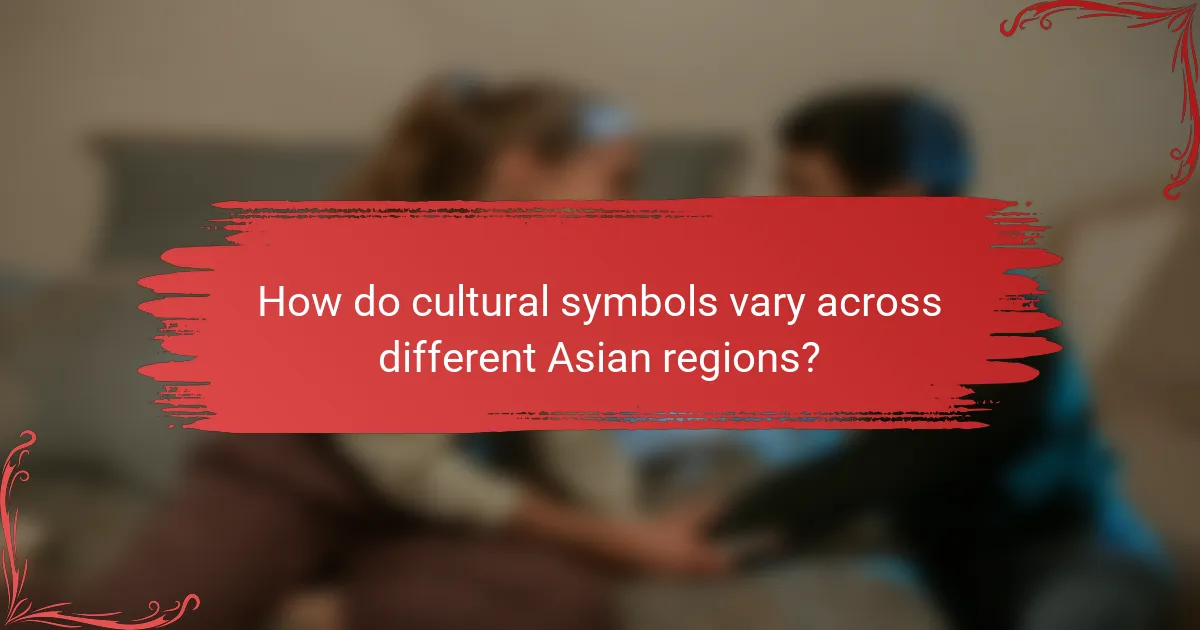Cultural symbols play a vital role in enhancing messaging across Asia, allowing for the swift and effective communication of complex ideas and emotions. By resonating with local audiences, these symbols make messages more relatable and impactful, reflecting the rich heritage and values of diverse societies. For brands, understanding and utilizing these symbols is essential to create meaningful connections with their target audiences while aligning with their core values.

How do cultural symbols enhance messaging in Asia?
Cultural symbols significantly enhance messaging in Asia by conveying complex ideas and emotions quickly and effectively. These symbols resonate with local audiences, making communication more relatable and impactful.
Visual storytelling techniques
Visual storytelling techniques leverage cultural symbols to create narratives that engage audiences. For instance, using traditional motifs or colors can evoke specific emotions or memories tied to cultural heritage. Brands often incorporate local art styles, such as Japanese ukiyo-e or Indian Madhubani, to create a connection with their audience.
Utilizing imagery that reflects local customs and values can enhance brand recognition and loyalty. For example, incorporating symbols like the lotus in marketing materials can resonate deeply with consumers in countries like India and Vietnam, where it holds significant cultural meaning.
Emotional resonance through symbols
Emotional resonance is achieved when cultural symbols tap into shared values and experiences. Symbols like the red envelope in Chinese culture, which represents good luck and prosperity, can evoke feelings of joy and celebration during festivals. Brands that use such symbols in their messaging can foster a deeper emotional connection with their audience.
Understanding the emotional weight of symbols is crucial. For instance, using the color white in certain Asian cultures may symbolize mourning, while in others, it may represent purity. Brands must be sensitive to these nuances to avoid miscommunication and ensure their messaging aligns with cultural sentiments.
Case studies from Asian brands
Several Asian brands effectively utilize cultural symbols in their messaging. For example, the Japanese brand Muji uses minimalist design and natural materials to reflect the cultural value of simplicity and functionality. This approach resonates well with consumers who appreciate the aesthetic of Japanese culture.
Another example is the Indian brand Amul, which frequently incorporates local symbols and humor in its advertisements. By using culturally relevant imagery and references, Amul successfully connects with a wide audience, reinforcing its brand identity and fostering customer loyalty.

What are key cultural symbols in Asia?
Key cultural symbols in Asia encompass a variety of elements that convey significant meanings and values across different societies. These symbols play crucial roles in branding, design, and communication, reflecting the rich heritage and beliefs of the region.
Lotus flower in branding
The lotus flower is a powerful symbol in many Asian cultures, representing purity, enlightenment, and rebirth. In branding, it is often used to evoke feelings of tranquility and spiritual growth, making it a popular choice for wellness and beauty products.
When incorporating the lotus into branding, consider its color variations, as different colors can convey distinct meanings. For example, a pink lotus symbolizes love and compassion, while a white lotus represents spiritual perfection. Using these colors thoughtfully can enhance the brand message.
Dragon as a symbol of power
The dragon is a prominent symbol of power, strength, and good fortune in various Asian cultures, particularly in China. Unlike the Western portrayal of dragons as malevolent creatures, Asian dragons are often seen as benevolent beings that bring prosperity and protection.
In branding, the dragon can be an effective way to project authority and confidence. Companies may use dragon imagery in their logos or marketing materials to align themselves with these positive attributes. However, it is essential to understand the cultural nuances and ensure that the representation resonates with the target audience.
Yin and Yang in design
Yin and Yang represent the duality of existence, emphasizing balance and harmony in life. This symbol is widely recognized in Asian philosophy and can be effectively utilized in design to convey a sense of equilibrium and interconnectedness.
When applying Yin and Yang in design, consider using contrasting colors and shapes to illustrate the balance between opposing forces. For example, pairing light and dark elements can create a visually appealing composition that reflects the essence of this philosophy. Avoid overcomplicating the design; simplicity often enhances the message of harmony.

How to effectively use cultural symbols in advertising?
To effectively use cultural symbols in advertising, brands must ensure that these symbols resonate with their target audience while aligning with their core values. This involves a deep understanding of the cultural context and the emotional connections that symbols evoke within specific communities.
Aligning symbols with brand values
When incorporating cultural symbols into advertising, it is crucial to align them with the brand’s core values and messaging. This alignment helps create authenticity and fosters trust among consumers. For instance, a brand that promotes sustainability should use symbols that reflect environmental stewardship, such as green leaves or recycling icons.
Brands should avoid using symbols that may contradict their values, as this can lead to consumer backlash. A clear understanding of the brand’s mission will guide the selection of appropriate symbols that enhance the overall message.
Understanding local cultural nuances
Understanding local cultural nuances is essential for effective messaging. Symbols can have different meanings across cultures, and misinterpretation can lead to negative perceptions. For example, while the color red symbolizes good fortune in many Asian cultures, it may represent danger in others.
Brands should conduct thorough research or collaborate with local experts to grasp the significance of various symbols. Engaging with local communities can provide insights that help avoid cultural faux pas and ensure that the messaging is respectful and relevant.
Testing audience reception
Before launching a campaign that utilizes cultural symbols, brands should test audience reception to gauge effectiveness. This can involve focus groups or surveys that assess how well the symbols resonate with the target demographic. Feedback can reveal whether the symbols evoke the intended emotions or if adjustments are necessary.
Brands should be prepared to iterate on their messaging based on audience feedback. A/B testing different symbols or messages can provide valuable data on consumer preferences, helping to refine the advertising strategy for maximum impact.

What are the risks of misusing cultural symbols?
Misusing cultural symbols can lead to significant misunderstandings and negative consequences for brands. It can alienate local audiences, damage brand reputation, and result in accusations of cultural appropriation.
Potential backlash from local audiences
Local audiences may react strongly against brands that misuse cultural symbols, perceiving it as disrespectful or exploitative. This backlash can manifest in social media outrage, protests, or boycotts, which can quickly escalate and affect public perception.
To avoid backlash, brands should engage with local communities and seek their input before using cultural symbols in marketing. Understanding the cultural significance and context is crucial for respectful representation.
Brand reputation damage
Missteps in using cultural symbols can lead to long-term damage to a brand’s reputation. Once trust is lost, it can take considerable time and effort to rebuild relationships with consumers.
Brands should prioritize authenticity and sensitivity in their messaging. Conducting thorough research and consulting cultural experts can help mitigate risks and enhance brand credibility.
Examples of cultural appropriation
Cultural appropriation occurs when elements of a culture are used without permission, often by those in a position of power. Notable examples include fashion brands using traditional garments or symbols without acknowledging their origins.
Brands should be cautious and respectful when incorporating cultural elements. For instance, using indigenous designs in fashion should be done with proper licensing and respect for the culture’s significance to avoid appropriation claims.

What frameworks exist for selecting cultural symbols?
Frameworks for selecting cultural symbols focus on understanding the cultural context and ensuring effective communication. These frameworks help businesses and organizations choose symbols that resonate with their target audience while avoiding misinterpretations.
Criteria for symbol selection
When selecting cultural symbols, consider relevance, familiarity, and emotional resonance. Symbols should be relevant to the target culture and easily recognizable by the audience. Additionally, they should evoke positive emotions and align with the values of the community.
For example, in many Asian cultures, symbols like the lotus flower represent purity and enlightenment. Choosing such symbols can enhance the effectiveness of messaging by connecting with the audience’s cultural values.
Evaluation matrices for messaging
Evaluation matrices can help assess the effectiveness of selected symbols in messaging. These matrices typically include criteria such as clarity, cultural appropriateness, and potential for misinterpretation. Each symbol can be rated against these criteria to ensure it meets the desired communication goals.
A simple scoring system can be employed, where symbols are rated on a scale from 1 to 5 for each criterion. This approach allows for a clear comparison and helps identify the most suitable symbols for specific messaging needs.

How do cultural symbols vary across different Asian regions?
Cultural symbols in Asia differ significantly across regions, reflecting diverse histories, beliefs, and social norms. Understanding these variations is crucial for effective communication and engagement in various cultural contexts.
Symbol significance in East Asia
In East Asia, symbols often carry deep historical and philosophical meanings, heavily influenced by Confucianism, Buddhism, and Taoism. For instance, the dragon symbolizes power and authority in Chinese culture, while in Japan, cherry blossoms represent the transient nature of life.
When engaging with East Asian cultures, it is essential to recognize the importance of these symbols in social interactions. Using culturally relevant symbols can enhance messaging, but misinterpretation can lead to misunderstandings. For example, colors like red are auspicious in China but may have different connotations elsewhere.
Differences in Southeast Asian cultures
Southeast Asia is characterized by a rich tapestry of cultures, each with unique symbols that reflect local traditions and beliefs. For example, the lotus flower is a significant symbol in many countries, representing purity and enlightenment in Buddhism, while in Indonesia, the wayang kulit (shadow puppetry) serves as a storytelling medium with cultural significance.
When communicating in Southeast Asia, it is vital to consider the specific cultural context of each country. Symbols that resonate in one nation may not have the same impact in another. For instance, while the color white is associated with mourning in some cultures, it symbolizes purity in others. Understanding these nuances can prevent cultural faux pas and foster better relationships.

What emerging trends are shaping cultural symbol usage in Asia?
Emerging trends in Asia indicate a dynamic evolution in the use of cultural symbols, influenced by globalization, technology, and shifting social values. These trends reflect a blend of traditional elements with modern interpretations, creating unique messaging strategies across diverse cultures.
Increased Digital Integration
The rise of digital platforms has transformed how cultural symbols are utilized in Asia. Brands are increasingly leveraging social media to communicate their messages, often incorporating traditional symbols in innovative ways to engage younger audiences. For instance, the use of emojis and memes that reference local cultural icons has become prevalent.
Companies should consider the digital context when using cultural symbols, ensuring they resonate with the target demographic. This may involve adapting traditional symbols to fit modern aesthetics or using them in interactive formats to enhance user engagement.
Cross-Cultural Influences
Cross-cultural exchanges are reshaping the landscape of cultural symbols in Asia. As international brands enter Asian markets, they often adapt their messaging to include local symbols, creating a fusion that appeals to both local and global audiences. This blending can enhance brand acceptance and loyalty.
Marketers should be mindful of cultural sensitivities when integrating symbols from different cultures. Misinterpretation can lead to backlash, so thorough research and collaboration with local experts are essential to ensure respectful and effective messaging.
Focus on Sustainability and Social Responsibility
There is a growing emphasis on sustainability and social responsibility in the use of cultural symbols across Asia. Brands are increasingly adopting symbols that represent eco-friendliness and community values, aligning their messaging with consumer expectations for ethical practices.
To effectively communicate these values, brands can incorporate symbols that signify environmental stewardship or social equity. For example, using motifs related to nature or community can enhance a brand’s image as socially responsible, appealing to the environmentally conscious consumer.
